Purpose: To compare the anatomical and functional outcomes, surgical duration, and complication rates between chandelier-assisted segmental scleral buckling (SB) and conventional SB in the treatment of primary rhegmatogenous retinal detachment (RRD).
Material and Methods: This retrospective comparative study included 19 phakic patients with primary RRD who underwent either conventional SB (Group 1, n = 9) or chandelier-assisted segmental SB (Group 2, n = 10). Patients were selected based on specific inclusion criteria including presence of anterior retinal breaks and PVR ≤ Grade C1. Group 1 underwent standard 360-degree SB with indirect ophthalmoscopy, while Group 2 underwent segmental SB with limited peritomy and chandelier-assisted wide-angle visualization under a surgical microscope. Primary outcomes included best-corrected visual acuity (BCVA) and anatomical reattachment at 1-year follow-up. Secondary outcomes included surgical duration and epiretinal membrane (ERM) formation.
Results: Both groups demonstrate successful retinal reattachment in all cases and significant improvement in BCVA at one year, with no statistically significant intergroup difference. Mean surgical duration was significantly shorter in the chandelier-assisted group (35.1 ±21.2 minutes) compared to the conventional group (70.2 ±23.2 minutes, p < 0.05). ERM formation was not significantly different between the groups, and no major intraoperative complications were noted.
Conclusion: Chandelier-assisted segmental SB is a safe and effective technique for managing selected cases of primary RRD. It offers comparable anatomical and visual outcomes to conventional SB, with the added advantages of reduced surgical time and improved intraoperative visualization.

